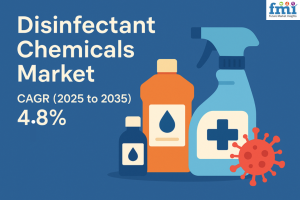Disinfectant Chemicals Market to Reach USD 4,404.8 Million by 2035, Driven by 4.8% CAGR and Rising Hygiene Regulations
In the UK, disinfectant use is rising in hospitals and kitchens, with the NHS pushing high-efficacy, eco-safe solutions for infection control.
Disinfectant chemicals are critical in preventing the spread of harmful pathogens, ensuring public safety, and maintaining hygiene across a variety of settings. These chemicals include a broad range of substances such as alcohols, chlorine compounds, aldehydes, peroxides, and quaternary ammonium compounds, each serving specific applications in hospitals, food processing facilities, public spaces, and residential environments.
Get Your Sample Report Now! https://www.futuremarketinsights.com/reports/sample/rep-gb-341
Key Market Drivers
1. Rising Healthcare Expenditure and Infection Control:
Hospitals, clinics, and long-term care facilities are among the largest consumers of disinfectant chemicals. Growing emphasis on infection prevention, sterilization protocols, and cross-contamination control has significantly increased product usage in the healthcare sector. Emerging economies are also increasing healthcare spending, improving hospital infrastructure, and aligning with global hygiene standards.
2. Global Awareness on Public Hygiene:
Public awareness campaigns around hand hygiene, surface disinfection, and personal protection—intensified during and after the COVID-19 pandemic—have left a lasting impact on consumer behavior. Consumers are more inclined to use disinfectants in households, educational institutions, gyms, and public transit systems, boosting demand.
3. Growth in Food Processing and Hospitality Industries:
In the food and beverage sector, disinfectant chemicals are essential for ensuring safety throughout the supply chain—from raw material handling to packaging. Stringent regulations regarding food safety and hygiene practices require regular disinfection of machinery, surfaces, and utensils. Similarly, hotels, restaurants, and resorts prioritize high hygiene standards to maintain brand trust and ensure guest safety.
Get the Full Report for Comprehensive Market Insights! https://www.futuremarketinsights.com/reports/disinfectant-chemicals-market
Regional Market Trends
North America continues to dominate the global disinfectant chemicals market owing to established healthcare infrastructure, rigorous sanitation regulations, and high public health awareness. Demand remains strong across hospitals, residential cleaning products, and institutional sectors.
Europe follows closely, supported by strict environmental and health safety laws. The region has seen increased adoption of eco-friendly disinfectant chemicals, especially in Western Europe.
Asia-Pacific is anticipated to witness the fastest growth, propelled by expanding healthcare sectors, government initiatives on sanitation, urbanization, and rising consumer awareness in countries such as China, India, and Southeast Asian nations.
Latin America and the Middle East & Africa are emerging markets where investments in healthcare and water sanitation infrastructure are gradually boosting the consumption of disinfectant chemicals.
Competitive Landscape
The disinfectant chemicals market is highly competitive with numerous multinational corporations and regional players focusing on product development, strategic mergers, and acquisitions. Companies are actively launching innovative products with enhanced antimicrobial efficacy, faster action, and environmentally safe ingredients to meet diverse customer requirements.
Leading Players in the Disinfectant Chemicals Market
• Ecolab Inc.
• Diversey Holdings Ltd.
• The Clorox Company
• BASF SE
• Reckitt Benckiser Group
• Spartan Chemical Company
• BioSafe Systems
• Sanosil AG
• Cleancore Solutions
• Zep Inc.
Latest Industrial and Institutional Chemicals Reports: https://www.futuremarketinsights.com/industry-analysis/industrial-and-institutional-chemicals
Key Segmentation
By Type:
• Liquids
• Sprays
• Wipes
• Others
By End User:
• Hospitals
• Households
• Food & Beverages
• Others
By Region:
• North America
• Latin America
• Western Europe
• Eastern Europe
• East Asia
• South Asia Pacific
• Middle East and Africa
Have a Look at Related Research Reports of Chemicals & Materials
Hydraulic Fluids Market Outlook: https://www.futuremarketinsights.com/reports/hydraulic-fluids-market
Mining Flotation Chemicals Market Share: https://www.futuremarketinsights.com/reports/global-mining-flotation-chemicals-market
Honing Oil Market Trends: https://www.futuremarketinsights.com/reports/honing-oil-market
Pharmaceutical Solvents Market Growth: https://www.futuremarketinsights.com/reports/pharmaceutical-solvents-market
Condensing Unit Market Demand: https://www.futuremarketinsights.com/reports/condensing-unit-market
About Future Market Insights (FMI)
Future Market Insights, Inc. (ESOMAR certified, recipient of the Stevie Award, and a member of the Greater New York Chamber of Commerce) offers profound insights into the driving factors that are boosting demand in the market. FMI stands as the leading global provider of market intelligence, advisory services, consulting, and events for the Packaging, Food and Beverage, Consumer Technology, Healthcare, Industrial, and Chemicals markets. With a vast team of over 400 analysts worldwide, FMI provides global, regional, and local expertise on diverse domains and industry trends across more than 110 countries. Join us as we commemorate 10 years of delivering trusted market insights. Reflecting on a decade of achievements, we continue to lead with integrity, innovation, and expertise.
Contact Us:
Future Market Insights Inc.
Christiana Corporate, 200 Continental Drive,
Suite 401, Newark, Delaware - 19713, USA
T: +1-347-918-3531
For Sales Enquiries: sales@futuremarketinsights.com
Website: https://www.futuremarketinsights.com
Ankush Nikam
Future Market Insights, Inc.
+91 90966 84197
email us here
Visit us on social media:
LinkedIn
Facebook
YouTube
X
Legal Disclaimer:
EIN Presswire provides this news content "as is" without warranty of any kind. We do not accept any responsibility or liability for the accuracy, content, images, videos, licenses, completeness, legality, or reliability of the information contained in this article. If you have any complaints or copyright issues related to this article, kindly contact the author above.
Civil Rights Icon Charles D. Neblett, PhD, Denied Critical Cancer Care Coverage Despite July 1 Medicare Policy Change
World Class Recording Artists to Perform at SoNo Collection July 3rd Rooftop Party Sponsored by Factory Underground Tech
Drawlux Celebrates 15,000 Custom Pet Portraits Created for Customers Worldwide
Więcej ważnych informacji
 Jedynka Newserii
Jedynka Newserii

 Jedynka Newserii
Jedynka Newserii

Polityka

Unijne mechanizmy ułatwiają zwiększenie wydatków na obronność przez europejskie kraje NATO. Ważnym aspektem infrastruktura podwójnego zastosowania
Wydatki na obronność w krajach NATO mają wzrosnąć do 2035 roku do 5 proc. PKB. W dużej mierze będzie to możliwe dzięki Unii Europejskiej, która stworzyła ramy umożliwiające krajom członkowskim realizację celów NATO w zakresie obronności, nie tylko poprzez finansowanie i inwestycje, ale także poprzez elastyczność budżetową. – To pełna synergia, można powiedzieć, że Unia Europejska współfinansuje razem z państwami członkowskimi cele zdolnościowe NATO – ocenia Paweł Zalewski, sekretarz stanu w Ministerstwie Obrony Narodowej.
Ochrona środowiska
Rusza budowa lądowej infrastruktury dla projektów Bałtyk 2 i Bałtyk 3. Prąd z tych farm wiatrowych popłynie w 2027 roku

Ruszyła budowa lądowej infrastruktury dla morskich farm wiatrowych Bałtyk 2 i Bałtyk 3 rozwijanych przez Equinor i Grupę Polenergia. To przede wszystkim baza serwisowa w Łebie i dwie stacje elektroenergetyczne. Jednocześnie trwają przygotowania do rozpoczęcia prac na morzu. Pierwszy prąd z obu projektów popłynie w 2027 roku, a w kolejce czeka morska farma wiatrowa Bałtyk 1 – największy i najbardziej zaawansowany projekt II fazy rozwoju offshore.
Edukacja
Uczelnie zaczynają wspólnie walczyć ze zjawiskiem mobbingu i dyskryminacji. Ruszają badania nad skalą problemu

Szkoły wyższe chcą aktywniej walczyć ze zjawiskiem mobbingu i dyskryminacji zarówno wobec pracowników, jak i studentów. W ramach projektu Bezpieczna Uczelnia będą się wymieniać dobrymi praktykami w zakresie polityki antymobbingowej. Zostaną przeprowadzone także badania na temat obecnej sytuacji w środowisku akademickim. Dotychczasowe badania prowadzone przez Fundację Science Watch Polska wskazują, że mobbing to dość powszechne zjawisko na uczelniach, które przybiera charakterystyczne dla środowiska formy.
Partner serwisu
Szkolenia

Akademia Newserii
Akademia Newserii to projekt, w ramach którego najlepsi polscy dziennikarze biznesowi, giełdowi oraz lifestylowi, a także szkoleniowcy z wieloletnim doświadczeniem dzielą się swoją wiedzą nt. pracy z mediami.








.gif)

 |
| |
| |
|